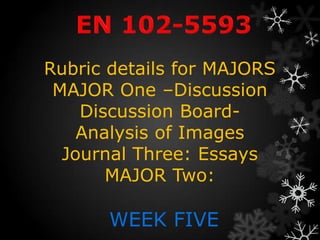The document provides rubrics and guidelines for two MAJORS assignments. [1] For MAJOR One, it discusses the key elements of paragraphs, including topic sentences, main ideas, and transition sentences. [2] For MAJOR Two, it instructs students to choose a topic using concepts and images, then narrow it down using clustering and news research. [3] Students will then develop a paper addressing the topic generally and using specific anecdotes and examples from the discussion board and their readings.



















